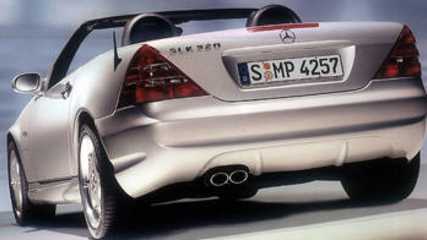Used Mercedes-Benz SLK review: 1997-2000
By Graham Smith · 28 Jan 2009
When most of us think of sports cars the image of a small, light, two-seater high on performance, but with few creature comforts, usually springs to mind. The image is a very British one, which can be explained by the predominance of British sports cars in the 1950s and 1960s when sports cars were a popular mode of transport.Anyone who cared, or dared, to look beyond the British brands, like MG, Austin-Healey or Triumph, would have found many other brands building distinctly different sports cars. Brands like Porsche and Mercedes-Benz were taking quite a different path with their cars, which didn’t fit the familiar British mould.Mercedes in particular was building sports cars on a much grander scale. Where British companies achieved levels of performance by using small mildly tuned engines in lightweight chassis, the Germans typically used bigger, more powerful engines in bigger cars.It was the same when the new wave of sports cars arrived in the late 1990s. The British sports cars were mostly confined to history by then, although MG enjoyed a resurgence and followed the old power-to-weight tradition by building a small light car with a tuned engine.Mazda mostly followed British tradition with the MX5, a small light car with a nimble chassis and a modestly tuned engine, while Mercedes followed its traditional path with the SLK, which was more sophisticated with lots of creature comforts to make the sports car experience a more enjoyable one for those not necessarily hooked on old time sports cars.MODEL WATCHThere was plenty of choice when Mercedes launched the SLK in 1997. Mazda had made sports cars popular once again and by 1997 there was a plethora of models on offer from a number of companies.No matter what your budget you could find a slinky drop top to suit your wants and desires.At $98,500 the SLK slotted into the middle segment of the market. It wasn’t cheap, but it wasn’t the most expensive sports car on the market either.Typically Mercedes the SLK came packed with the latest technology. It had a clever steel roof that folded out of sight into the boot when you wanted to soak up the sun, but provided all of the security and comfort of a coupe when raised.It was the best of both worlds and the forerunner of many more models that would follow in the years after the SLK’s arrival.The only downside to the roof was that it slashed the available boot space once it was lowered. It was best to travel lightly if you were touring in an SLK.Chunky was the best word to describe the SLK with its wedge shape and large flanks, but it was attractive whichever way you looked at it.It was a little cramped inside, but it was stylish. The seats were typically ’Benz, flat and broad, which meant most people would fit in them, but they didn’t provide the best of support in the sports car tradition.The trim was a dashing blend of bright colours, leather of course, and there was a touch of nostalgia with the classical instruments and retro alloy touches on the centre console.At first there was just the one engine option available. It was a supercharged 2.3-litre double overhead camshaft four-cylinder unit that pumped out 142 kW at 5300 revs and 280 Nm at 2500 revs.When stirred into action the SLK230 was capable of accelerating from rest to 100 km/h in 7.6 seconds.As with the engine there was only one choice when it came to transmissions, and it was a five-speed auto. True, it could be shifted manually when you wanted to up the fun stakes, but it wasn’t in the class of the Porsche Tiptronic, and a long way short of a real manual ’box.Underneath lay independent suspension front and rear, four wheel discs with ABS, traction control and power steering.Inside there was standard air-conditioning, power windows, the roof was powered, remote central locking, immobiliser, and dual airbags.On the road the SLK behaved well. It handled nicely, rode comfortably, braked with assurance, but was geared more to highway driving than spirited driving down a winding country lane.A few months after the initial launch Mercedes offered a slightly cheaper SLK200 model with a 100 kW unblown 2.0-litre engine in place of the supercharged 2.3-litre unit.IN THE SHOPMercedes-Benz cars generally stand the test of time well, and with around 100,000 km on average on the odometer the SLK models are still in their prime when it comes to service.When checking one with the thought of purchase check for a service record because it’s better to buy one that has been cared for by a ’Benz dealer or at least an acknowledged specialist than one that hasn’t been serviced properly.Have it checked by a specialist who knows the make and model.Unlike some other sports cars the SLK is unlikely to be used in motor sport so they’re not normally abused.OWNERS SAYJanice Hyndman has travelled 54,000 km in her SLK230 and loves driving it, particularly on a sunny day when she can lower the roof. She loves the uncluttered, classical style, says it has sufficient power, and the boot is roomy enough for her needs. While she says it’s comfortable for her, her husband finds it a little cramped, particularly in the foot wells. Apart from a window winder motor that required replacing Janice says her SLK has been very reliable.LOOK FOR• Classical styling• great folding steel roof• comfortable ride• secure handling• good performanceTHE BOTTOM LINEGood looking drop top that makes a perfect cruiser on a sunny day.RATING90/100








